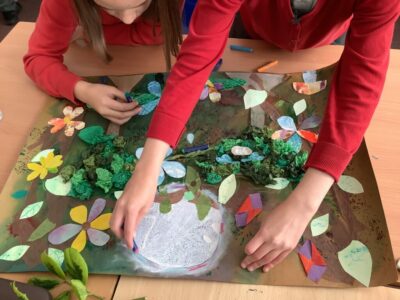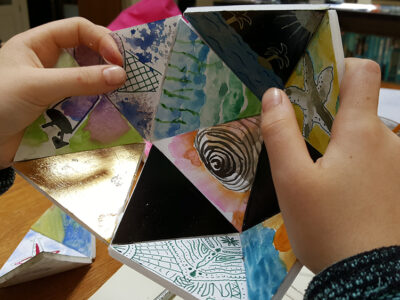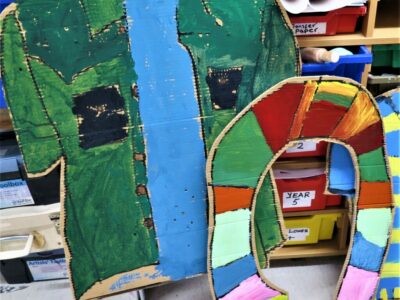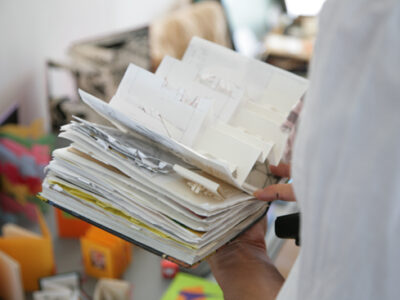Being an Art Lead can be exciting but it can also be challenging, especially if your experience in art is limited. Find guidance and information below to help support your role.
First Things First!

AccessArt believes all children have the right to an excellent and rigorous art education.
But we need to acknowledge that teachers and schools are under incredible pressure from all sides. We recognise that in many schools, specialist primary art teachers are now a thing of the past, and that many teachers have limited experience in teaching (or studying) art.
We want to make it possible for ALL schools to deliver a great art education for their pupils. We offer the resources below in good faith, and we hope the information below helps less experienced art teachers to feel comfortable and inspired in delivering an exciting art curriculum. We are here to help so please get in touch!
The AccessArt Ethos
If you are looking for curriculum support in art it ‘s important that you choose an organisation or company which has a similar ethos or values to yourself. Here’s what we stand for at AccessArt.
AccessArt advocates:
-
Before we decide what* and how** we teach within the umbrella of “art”, we should remember why we are teaching art in the first place. At AccessArt we remind everyone that we teach art because it is one way we can enable children to reach their creative potential. Every child is entitled to develop their critical and creative thinking skills, and to build their knowledge and understanding of materials and techniques, developing their experience of how they can make a creative response to a variety of stimulus, and our role as teachers is to facilitate this journey. So for AccessArt, remembering our core aim is to enable creativity, we place an emphasis on encouraging exploratory journeys, working towards varied and individual outcomes.
-
Art teaching should be aspirational yet accessible. We specialise in creating resources which help all teachers, including non-specialist teachers, to feel confident and enable to deliver inspirational activities to all children. You do not have to be “good at art” to be a great art teacher – you only need to be willing to explore, alongside your pupils, modelling an attitude of curiosity, open-mindedness, creative-risk taking and reflection.
-
Our offering to pupils should be broad and rich, contemporary and diverse. By keeping our understanding of all discipline areas (drawing, painting, printmaking, sculpture etc) as open as possible we ensure that we keep art as inclusive and accessible to every child.
-
Teaching art can and should be as rigorous and disciplined as any other subject. Enabling open-ended creative learning actually requires teachers to understand the structures and spaces pupils need to work to their best.
-
That we build skills and knowledge through a combination of opportunities for repeated practice and new projects. Art is subjective and experiential – and there are many types of “knowledge” all of which are best understood when the knowledge is embedded in experience.
-
We cannot and should not apply the same metrics to art as to other subjects. Art is a unique subject to teach/facilitate and we should embrace that fact.
-
Through enabling pupils to think about the purpose of art and artists to all our lives, we will ensure that as children grow they feel entitled to express and better understand themselves (and the world in which they live) through making and talking about art. Through this creative entitlement we help nurture citizens who feel empowered to help shape community and society for the better.
How** – As inspected by Ofsted
AccessArt Offers Two Main Ways to Help You Develop a “Broad, Rich, Contemporary & Diverse” Creative Curriculum…
Follow the AccessArt Primary Art Curriculum

Launched in 2022, the new AccessArt Primary Art Curriculum consists of 36 pathways which can be adapted to suit your school. Find out more.
Or…
Use our Individual Resources to Support Your Existing Curriculum

Find out how you can use AccessArt resources to supplement and develop your existing art curriculum.
Attend High Quality, Inspirational CPD
AccessArt offers CPD designed to inspire and enable. Find out more about our rolling programme of ticketed zoom CPD, led in-house and in collaboration with experts in the field, and learn more about tailored CPD for schools.

Understanding Progression in Art
Unlike in many other subjects, there is no given sequencing in art. As much as many would like art to be a “tidy” subject which can be slotted into convenient boxes, approaching art in this way can stifle creativity. We need to think differently about progression in art.
Explore the following resources to help you think about Progression in Primary Art:
How Do Non-Specialist Teachers Teach Art?
How Do We Assess Art?
Why Visual Literacy Is An Important Skill
What Is Drawing?
Making Is Hard
How Do We use Artists in schools?
AccessArt Recommends…
That schools consider teaching art & design at Key Stage 1 and 2 as a distinct subject. Whilst we appreciate many schools approach art in a project or theme-based manner, our experience is that when art is taught as a distinct subject in a skills-based manner there is clearer progression and the teaching and learning is more rigorous. We do appreciate that art provides an excellent way to enrich the currciulum and link to other curriculum areas. Links to themes or projects can still be made, but from a position of far greater strength and understanding.
That schools work hard to break down preconceptions amongst teachers and pupils as to what drawing or sculpture (for example) is or might be. Preconceptions can stifle creativity. If we take the lid off art and design we can allow the subject to flourish. Experimentation, risk, and innovation should be encouraged.
Art is a large subject area and you cannot possibly cover everything – its for you to decide as a school what you teach whilst meeting the aims of the national curriculum. Elements such an exploration of line, colour, form shape etc are woven throughout the disciplines. It might be helpful to think about subject areas as being: Drawing, Sketchbooks, Printmaking, Sculpture, Design, Painting, Craft, Textiles, and Digital.
Please explore each of the subject areas above for further guidance and links to resources/lessons plans.
We Propose…
That teachers and schools raise their expectations as to what pupils are capable of in the visual arts. This can happen in a very practical way: for example through the introduction of a wider variety of materials from the outset, pupils can and do quickly build their understanding and skills.
We Suggest…
That schools should be less focussed on outcome and more focussed on the creative journey. When schools work towards a predefined, prescribed outcome (i.e. in the case of a display) the understanding and learning of pupils can be compromised. Ofsted recognises that work which looks great at first glance can often hide poor learning outcomes. Instead schools should work to create confident, independent artists who can articulate and value their own creative journeys.
We suggest that each term children should be given the opportunity to explore a variety of polarities:
-
Traditional skills should be balanced with experimental work.
-
Small scale work should be balanced with large scale work.
-
Quiet reflective study should be balanced with active, dynamic work.
-
Individual work should be balanced with group work.
-
Two dimensional work should be balanced with three dimensional work.
-
Study of historical “great” artists should be balanced with contemporary artists.
In addition children should be given the opportunity to experience:
-
How it feels to take creative risks as opposed to playing it safe
-
That chaos and mess can be productive for some people
-
Both female and male creative role models (including visits from artists/visits to galleries/artists studios)
Practical Pointers…
-
That for many schools, an ongoing exploration of materials will provide an accessible and effective starting point. This exploration (of materials used for drawing, sculpture, painting, printmaking etc) will help the children grow in confidence and understanding and promote self-directed learning. Manipulating materials helps children explore processes, and these in turn can be applied to concepts. Many of the resources in the subject areas (see links above or below) centre around an exploration of materials and processes.
You might want to consider:
-
A whole-school activity. For example, all year groups might explore charcoal. Each class and individuals within the class will naturally explore at his or her own level. Fundamental exercises can be experienced by all ages, and repeated by all ages, as part of their practice. There is no need for a “progression of activity” as such – children will naturally progress once they have repeated access to a material, process or concept.
-
Pupils or teachers sharing areas of expertise with other classes to build knowledge and confidence within the school.
-
That teachers should not be afraid to be seen to be learning alongside the children – in fact this can be a very positive role model for children.
Find More Information & Resources for Primary Teachers
Click here for more resources and opportunities to support a creative curriculum in your school
Useful Links



